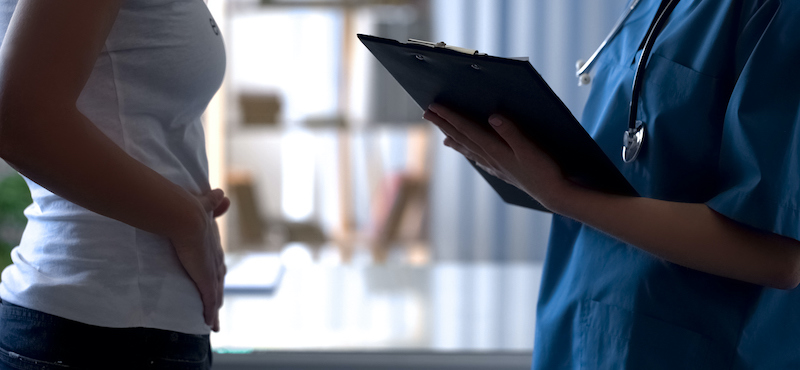When it comes to reproductive health, there are several issues women are familiar with — such as premenstrual syndrome (PMS), contraceptives, and the need to get an annual well-woman exam. However, there are other concepts that are less recognizable, until an OB-GYN mentions them during a routine pelvic exam. Such tends to be the case with uterine fibroids.
What are Uterine Fibroids?
Uterine fibroids — also known as leiomyomas or myomas — are growths in the uterus that occur during childbearing years. They range greatly in size, from a seed to enlarging so much that the uterus reaches the ribs. Some women develop only one uterine fibroid, while others could have several of them.
If the fibroids are small, they rarely have an effect on pregnancy. If they are large, they could cause pregnancy complications, including breech presentation, preterm birth, or miscarriage. Uterine fibroids sometimes shrink after menopause — due to a drop in estrogen and progesterone.
Causes of Uterine Fibroids
Uterine fibrosis could be caused by several factors, including high levels of estrogen and progesterone, vitamin D deficiency, growth hormones, stress, pregnancy, being overweight, or family history.
Symptoms of Uterine Fibroids
For most women, uterine fibroids do not cause any symptoms. They are usually discovered during a routine pelvic exam or an ultrasound during pregnancy. It’s also possible for women to have fibroids at some point in their lives and not realize it. However, if the growths are larger, women may experience:
- Lower back pain
- Pain during intercourse
- Pressure on the lower abdomen
- Swelling of the lower abdomen
- Frequent urination
- Heavy periods
- Periods that last longer than a week
- Constipation
Types of Uterine Fibroids
The type of fibrosis a person can develop depends on where in the body the growths are located. The location can also impact the symptoms experienced.
Intramural Fibroids
Intramural are the most common types of fibroids. They develop within the walls of the uterus. They are also the type of tumors that could grow larger than other fibroids and stretch the womb.
Subserosal Fibroids
Outside every organ, there’s a smooth layer of tissue called serosa. Its purpose is to lubricate organs to reduce friction from muscle movement. When fibroids occur on the serosa surrounding the uterus, they are called subserosal.
Pedunculated Fibrosis
On some occasions, subserosal fibroids develop a stem — also known as a peduncle. When this occurs, the growths are known as pedunculated fibrosis.
Submucosal Fibroids
These types of tumors are located in the middle muscle layer of the uterus — also known as the myometrium. This portion of the uterus induces contractions.
Diagnosis and Treatment for Uterine Fibroids
If your OB-GYN suspects uterine fibroids, they will order imaging testing to confirm the diagnosis. Treatment options include birth control pills or other types of drugs or devices that regulate your menstrual cycle. While they do not eliminate the fibroids, they can reduce their size. Other types of medications — known as gonadotropin-releasing hormones or GnRH — include:
- Lupron
- Zoladex
- Eligard
- Trelstar
Your doctor may also recommend avoiding meats and high-calorie foods and increasing your consumption of dark leafy greens, green tea, fish, and foods high in flavonoids — such as berries, citrus fruit, peaches, tomatoes, broccoli, apples, peppers, and cocoa.
Are Uterine Fibroids Related to Cancer?
Uterine fibroids are non-cancerous. They are also not associated with an increased risk of cancer. As such, they are known as benign tumors — and are the most common growths in women and the leading cause of hysterectomies.
Surgery Options for Uterine Fibroids
There are several surgery options to treat uterine fibroids. The most common include:
Uterine Artery Embolization
This is a minimally invasive procedure, where a radiologist makes a small incision on the groin after applying local anesthesia. Small particles are injected through a catheter to cut off the blood supply to the fibroids.
Myomectomy
This operation involves making an incision on the abdomen to access the uterus. The fibroids are removed, but the uterus remains in place to allow the woman to become pregnant in the future. It’s possible for the fibroids to grow again after surgery.
Endometrial Ablation
This procedure involves the removal of the endometrial lining — the tissue lining the uterus. The procedure is minimally invasive and requires no incision. Your doctor inserts the necessary substances through the vagina.
Hysterectomy
This type of surgery would only be done as a last resort — since it involves removing the uterus. It’s typically performed on postmenopausal women who experience pain from the fibroids.
OB-GYN Women’s Center Can Provide Treatment
At OB-GYN Women’s Center, we understand that when faced with infertility, things can get heartbreaking and overwhelming.
Contact us to schedule an appointment. Let’s discuss your options and find out the best course of action for you.


